Of Old Radios And Related Items--Published Monthly
Meet the Beatles Radio:
The Pepsi-Cola Transistor RadioBY RON BOUCHER
Web Edition
One of the most intriguing aspects of the following article is the connection made between the Pepsi radio and the famous Beatles singing group. The recent death of George Harrison, lead guitarist of the group, brought an outpouring of grief and nostalgia from fans that reminded us once again of the impact the Beatles had on the music and lifestyle of the 1960s and beyond.
Unfortunately, after chasing down a long legal trail, we were denied the rights to publish still photos from the documentary, "The Beatles: The First U.S. Visit" in which the Pepsi radio appears; however, Ron has done a great job painting the pictures with words. (Editor)
Some of our most collectible radios have characters depicted on them. For example, there are the Charlie McCarthy, the Hopalong Cassidy, and Dionne Quintuplet radios. What I am calling the Beatles radio, is actually made to look like a Pepsi Cola vending machine. What makes it the Beatles radio is the fact that the Beatles collectively owned one.
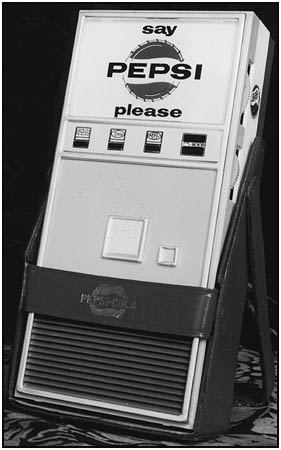
The Pepsi radio standing in its red leather carrier. The buttons indicate a choice of drinks: Teem, Patio, and, of course, Pepsi.
The Radio
This radio is a 9-transistor superhet portable made by the Tokyo Electric Industry Company for Pepsi-Cola in New York City and marketed by Industrial Contacts Inc., also in New York. It measures 31/8" x 19/16" x 611/16" tall (80 x 40 x 70 mm) and is molded in red, white and blue. It comes with a red leather carrier. On some examples, the outside of the blue (front) section has faded to greenish blue. The inside is usually the original blue.
A screw secures the red back cover, but even with that screw undone, molded-in detents still hold it on. It's a tight fit, and you have to pry the cover off. All examples I've seen either have cracks or pieces missing in the corners because of this problem. The damage occurs when the back is taken off to replace batteries. Be careful.
On the front, under a clear plastic bubble, are the words, "Say Pepsi Please." The drinks offered are Patio, Teem and Pepsi.
The radio is AM only and runs on four AA batteries, which were called "penlight" back then. It is actually a pretty good performer and pulls in a lot of stations at night. An earphone with carrying pouch was supplied. I listened to one with modern full-size headphones and found the tone to be quite good, with plenty of bass and volume, which is all wasted on the built-in 21/2" speaker.
These radios originally came in relatively nice boxes. On the sides are the following words: "Distortion free tuning Amazing range Nine transistor circuit for power & range Lightweight Compact Pocketable Outstanding selectivity Perfect tonal quality." I agree with the performance claims!
During the Beatles' first tour of America, the local New York radio stations played a large role in their success. This radio was one of their links to these stations.
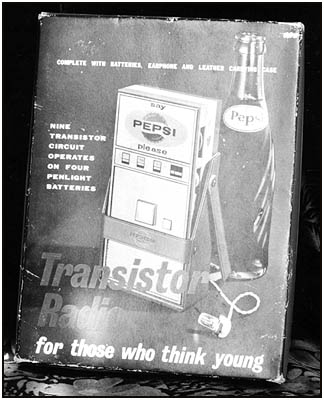
The cover of the Pepsi box labeled with the motto, "For those who think young" and showing the well known bottle itself in the rear.
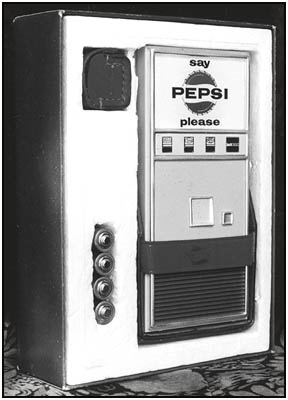
The Pepsi radio in its neatly fitted box with the earphone in its case and batteries.
The Beatles Connection
So, how and why did the Beatles end up owning one of these radios? The documentary film The Beatles: The First U.S. Visit tells the story.
The year is 1964. On February 7, John, Paul, George and Ringo are flying to New York for their first appearance on the "Ed Sullivan Show," as well as for a concert tour that includes Washington D.C. and New York's Carnegie Hall.
Capitol Records has recently taken over the release of the Beatles' records in the U. S. and is spending an unprecedented $50,000 on a promotion campaign. This includes wigs, "Beatles are Coming" posters, and other promotional activities. It's working!
New York radio stations, especially WMCA 570 and WINS 1010, are going all out in publicizing the Beatles' arrival. WMCA is announcing the time as "Beatle time." The stations are actually following the progress of the flight. WINS 1010 DJ and promoter Murray the K is especially enthusiastic and would eventually make his way into the Beatles' entourage.
At 1:20 p.m., Pan Am flight 101 arrives in New York, at the newly renamed Kennedy Airport. The Beatles are not expecting the reception they are about to receive. On the flight, George had said "They have everything over there. What do they want us for?" He had been to America once before.
As the plane taxis up the runway, they are all looking out the windows. When it pulls up to the terminal, they are surprised by the sight of the crowd. They think the reception is for someone else. Not so.
After a press conference, they leave the airport in four Cadillacs and head for the Plaza Hotel on 5th Avenue near Central Park South. As soon as they are underway, the car radios are switched on so they can hear if anything is being said about them. They are finally hearing the sound of American commercial radio firsthand. This is not at all like the BBC.
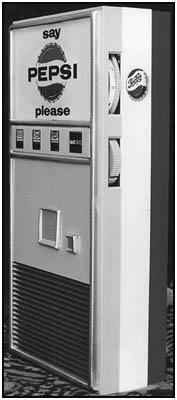
The Pepsi radio sports patriotic colors -- red for the back cover, white, and blue for the front which sometimes fades to greenish blue.
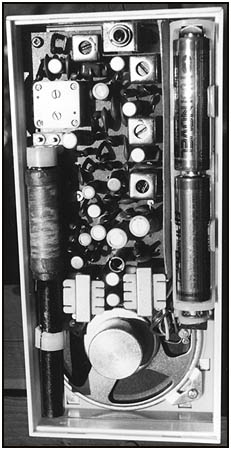
The inside of the Pepsi radio showing two of four batteries on the right, the antenna on the left, and the speaker on the bottom.
That evening they watch the 6 o'clock news to see if their arrival was being reported. By now, our Beatles/Pepsi radio is on the coffee table in their room on the 12th floor. No doubt someone from Pepsi arranged for them to have it there.
At that point, they are really tired because for them, it is nighttime. George seems to be the most exhausted because, by then, he is having tonsil problems. He will skip rehearsals and sightseeing the following day.
The next day, February 8, they go for a photo session in Central Park. The Pepsi radio is with them, but George is not. He remains sick at the hotel.
About 4:30 p.m. that day, leaving the ailing George behind Ringo, John, and Paul go to meet representatives of Rickenbacker Guitars. The company had set up a display in rooms 904-905 at the Savoy Hilton Hotel near Central Park where they presented the Beatles with a 12-string electric guitar. The three brought it right back to George at the hotel. George used it the following week for rehearsals in Miami, as well as later in their first movie A Hard Days Night.
During a radio interview, George mentioned the guitar and said how much he liked it. As a gimmick, the announcer offered to buy the guitar for him. But, of course, George already owned it.
After the interview at Rickenbacker Guitars, the Pepsi radio is not seen again in the film. I wonder if they forgot it at Rickenbacker when they grabbed the guitar. Paul was then carrying the radio.
Murray the K interviewed them by phone and later showed up in their room. The Beatles couldn't understand how he pulled that off. He was in their room the day of the Ed Sullivan show and took them out on the town that evening. He also went with them on the train trip to Washington. It was snowing and they didn't want to travel by air in a blizzard.
On the afternoon of Sunday, February 9, the Beatles taped their first performance for broadcast later on February 23. That evening, their second performance was broadcast live from Ed Sullivan's Studio 50 at 524 West 57th St. The following week, on Sunday, February 16, they broadcast a second live show from Miami. They returned to London on February 22.
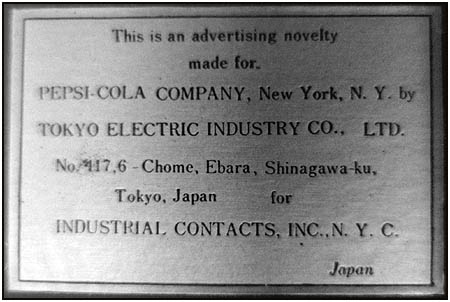
The radio is labeled in detail: "This is an advertising novelty made for Pepsi-Cola Company, New York, N. Y., by Tokyo Electric Industry Co., LTD. No. 117.6 - Chrome, Ebara, Shinagawa-ku, Tokyo, Japan for Industrial Contacts, Inc., N. Y. C. Japan."
The Film and the Pepsi Radio
The Beatles, The First U.S. Visit covers the Beatles' arrival; events at the New York and Miami hotels; the Central Park photo shoot; their night out with Murray the K; the train trip; some Ed Sullivan performances, including the one in Miami; and their return to London.
The film was edited to make a good story and the sequence isn't always correct. For example, what is supposed to be the limousine trip from the New York airport to their hotel was actually shot the next day. I think they were trying to make it a real-life version of A Hard Days Night.
The Beatles were fascinated with American commercial radio and American music which they listened to on the Pepsi radio. It was especially handy when they did phone interviews, which they granted left and right. They even unknowingly endorsed some bootleg recordings of themselves. They also each had smaller radios with earphones and called in requests for songs other than their own.
As a Beatles fan, as well as a radio and guitar collector, I became very interested in this radio and finally acquired one. Though it is seen many times in the film, I've never seen it in any photos.
(Ron Boucher, ronboucher@mediaone.net)
Ron Boucher has been collecting radios since the late 1970s and specializes in radios of the early 1930s. He was an active seller in the 1980s. In the 1990s, he created several pieces of radio-related artwork for radio collector magazines.
References
Bacon, Tony and Paul Day. The Rickenbacker Book. San Francisco: GPI Books, 1994.
The Beatles, An Illustrated Diary. London: Plexus Publishing, 1998.
Beatles Anthology -- The Beatles -- 2000. San Francisco: Chronicle Books, 2000.
Davies, Hunter. The Beatles. New York: Dell Publishing, 1968.
Davis, Andy. The Beatles Files. New York: Quadrillion Publishing, 1998.
http://musicradio.computer.net/wmca/beatles.html to hear John & Ringo plugging WMCA
Leach, Sam. Beatles on Broadway. Racine, Wis.: Whitman Publishing, 1964.
Lennon, Cynthia. A Twist of Lennon. New York: Avon Books, 1980.
Lewishohn, Mark. The Beatles Day by Day. New York: Harmony Books, 1989.
Maysles Films Inc. Production, © Apple Corps, Ltd. The Beatles: The First U.S. Visit, 1991.
Norman, Philip. Shout. New York: Warner Books, 1981.
| [Free Sample] [Books, etc., For Sale] [Subscribe to A.R.C./Renew] [Classified Ads] [Auction Prices] [Event Calendar] [Links] [Home] [Issue Archives] [Book Reviews] [Subscription Information] [A.R.C. FAQ] URL = http://www.antiqueradio.com/Feb02_Meet_Beatles.html Copyright © 1996-2002 by John V. Terrey - For personal use only. Last revised: January 28, 2002. For Customer Assistance please contact ARC@antiqueradio.com or call (866) 371-0512 Pages designed/maintained by Wayward Fluffy Publications
Antique Radio Classified |